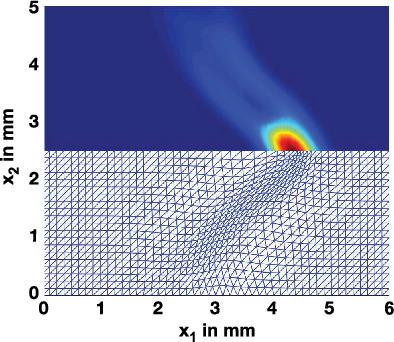当前位置:
X-MOL 学术
›
Int. J. Numer. Methods Fluids
›
论文详情
Our official English website, www.x-mol.net, welcomes your feedback! (Note: you will need to create a separate account there.)
An Adaptive Moving Finite Element Method for Steady Low Mach Number Compressible Combustion Problems
International Journal for Numerical Methods in Fluids ( IF 1.8 ) Pub Date : 2020-02-17 , DOI: 10.1002/fld.4818 Zhen Sun 1 , Malte Braack 2 , Jens Lang 1
International Journal for Numerical Methods in Fluids ( IF 1.8 ) Pub Date : 2020-02-17 , DOI: 10.1002/fld.4818 Zhen Sun 1 , Malte Braack 2 , Jens Lang 1
Affiliation

|
This work surveys an r-adaptive moving mesh finite element method for the numerical solution of premixed laminar flame problems. Since the model of chemically reacting flow involves many different modes with diverse length scales, the computation of such a problem is often extremely time-consuming. Importantly, to capture the significant characteristics of the flame structure when using detailed chemistry, a much more stringent requirement on the spatial resolution of the interior layers of some intermediate species is necessary. Here, we propose a moving mesh method in which the mesh is obtained from the solution of so-called moving mesh partial differential equations. Such equations result from the variational formulation of a minimization problem for a given target functional that characterizes the inherent difficulty in the numerical approximation of the underlying physical equations. Adaptive mesh movement has emerged as an area of intense research in mesh adaptation in the last decade. With this approach points are only allowed to be shifted in space leaving the topology of the grid unchanged. In contrast to methods with local refinement, data structure hence is unchanged and load balancing is not an issue as grid points remain on the processor where they are. We will demonstrate the high potential of moving mesh methods for effectively optimizing the distribution of grid points to reach the required resolution for chemically reacting flows with extremely thin boundary layers.
中文翻译:

稳定低马赫数可压缩燃烧问题的自适应移动有限元方法
这项工作调查了预混层流火焰问题的数值求解的 r 自适应移动网格有限元方法。由于化学反应流模型涉及许多不同长度尺度的不同模式,因此此类问题的计算通常非常耗时。重要的是,为了在使用详细化学时捕捉火焰结构的重要特征,需要对某些中间物种的内部层的空间分辨率提出更严格的要求。在这里,我们提出了一种移动网格方法,其中网格是从所谓的移动网格偏微分方程的解中获得的。此类方程源于给定目标函数的最小化问题的变分公式,该函数表征了基础物理方程数值近似的固有困难。在过去的十年中,自适应网格运动已成为网格自适应研究的一个热点领域。使用这种方法,点只允许在空间中移动,而网格的拓扑结构保持不变。与具有局部细化的方法相比,数据结构因此保持不变并且负载平衡不是问题,因为网格点保留在它们所在的处理器上。我们将展示移动网格方法在有效优化网格点分布以达到具有极薄边界层的化学反应流所需的分辨率方面的巨大潜力。
更新日期:2020-02-17
中文翻译:

稳定低马赫数可压缩燃烧问题的自适应移动有限元方法
这项工作调查了预混层流火焰问题的数值求解的 r 自适应移动网格有限元方法。由于化学反应流模型涉及许多不同长度尺度的不同模式,因此此类问题的计算通常非常耗时。重要的是,为了在使用详细化学时捕捉火焰结构的重要特征,需要对某些中间物种的内部层的空间分辨率提出更严格的要求。在这里,我们提出了一种移动网格方法,其中网格是从所谓的移动网格偏微分方程的解中获得的。此类方程源于给定目标函数的最小化问题的变分公式,该函数表征了基础物理方程数值近似的固有困难。在过去的十年中,自适应网格运动已成为网格自适应研究的一个热点领域。使用这种方法,点只允许在空间中移动,而网格的拓扑结构保持不变。与具有局部细化的方法相比,数据结构因此保持不变并且负载平衡不是问题,因为网格点保留在它们所在的处理器上。我们将展示移动网格方法在有效优化网格点分布以达到具有极薄边界层的化学反应流所需的分辨率方面的巨大潜力。



























 京公网安备 11010802027423号
京公网安备 11010802027423号